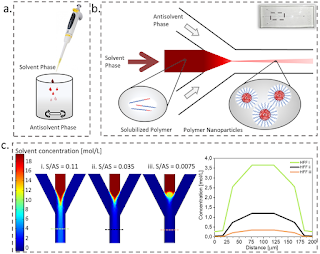Nanoparticles are typically generated by precipitation of hydrophobic polymers into an aqeous emulsion in which the polymer particles form inside the emulsified droplets of organic solvent in the emulsion mix. The way in which this emulsion is achieved can vary widely from simply rapid agitation of water-surfactant mixtures in an open-top container to precisely controlled microfluidic systems for generation of very uniform particles. Recently, researchers at Institute for Bioengineering of Catalonia, The Barcelona Institute of Science and Technology (Spain), and Eindhoven University of Technology (Netherlands) used PLGA (AP082) and PEG-PLGA (AK102) from PolySciTech (www.polyscitech.com) to research microfluidic generation of block-copolymer based nanoparticles. This research holds promise to improve the development of drug-loaded nanoparticles for treating a wide array of disease states including cancer. Read more: Mares, Adrianna Glinkowska, Gaia Pacassoni, Josep Samitier Marti, Silvia Pujals, and Lorenzo Albertazzi. "Formulation of tunable size PLGA-PEG nanoparticles for drug delivery using microfluidic technology." PloS one 16, no. 6 (2021): e0251821. https://journals.plos.org/plosone/article?id=10.1371/journal.pone.0251821
“Abstract: Amphiphilic block co-polymer nanoparticles are interesting candidates for drug delivery as a result of their unique properties such as the size, modularity, biocompatibility and drug loading capacity. They can be rapidly formulated in a nanoprecipitation process based on self-assembly, resulting in kinetically locked nanostructures. The control over this step allows us to obtain nanoparticles with tailor-made properties without modification of the co-polymer building blocks. Furthermore, a reproducible and controlled formulation supports better predictability of a batch effectiveness in preclinical tests. Herein, we compared the formulation of PLGA-PEG nanoparticles using the typical manual bulk mixing and a microfluidic chip-assisted nanoprecipitation. The particle size tunability and controllability in a hydrodynamic flow focusing device was demonstrated to be greater than in the manual dropwise addition method. We also analyzed particle size and encapsulation of fluorescent compounds, using the common bulk analysis and advanced microscopy techniques: Transmission Electron Microscopy and Total Internal Reflection Microscopy, to reveal the heterogeneities occurred in the formulated nanoparticles. Finally, we performed in vitro evaluation of obtained NPs using MCF-7 cell line. Our results show how the microfluidic formulation improves the fine control over the resulting nanoparticles, without compromising any appealing property of PLGA nanoparticle. The combination of microfluidic formulation with advanced analysis methods, looking at the single particle level, can improve the understanding of the NP properties, heterogeneities and performance.”

No comments:
Post a Comment